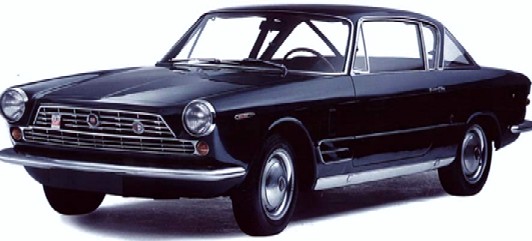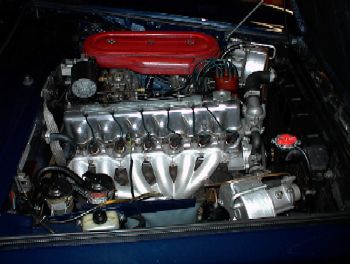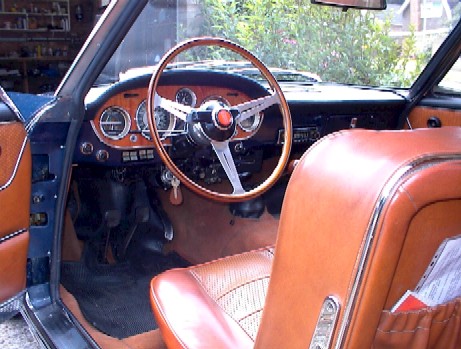By Ricky Reid
One of Fiat’s better offerings that, looking back 40 years later, seems to have happened almost by accident!
Back in the 1950’s, Fiat launched their 2100 station wagon, a model aimed at the lucrative USA market that incorporated styling from Fiat’s perception of “What America wanted”. Whilst the car benefited from very sound engineering (an ex-Ferrari engineer Lampredi designed the engine and in particular the hemispherical head), it was not a great selling success in the USA and its’ shape did not appeal to the European taste.
Ghia, who were at that time still a family owned styling house, took the platform of the 2100 and transformed the car into the shape above. It had always been my understanding that the main influence behind the design of the car came from a new recruit to Ghia, a young American designer called Tom Tjaarda. That understanding has recently been corrected by Rainer Schon, who runs an interesting Website for the 2300 at http://home.t-online.de/home/fiat2300.register/. Rainer tells me that the main design was by Sergio Sartorelli, who was the manager of Ghia’s Design division and that Tjaarda had a minor input only.
Ghia put the car on show in the 1960 Turin Show, and “laid down the gauntlet” to Fiat by announcing that they (Ghia) were to put the car into production.
Fiat who were looking for an up-market performance car to use to enter the GT market in the early 1960’s, told Ghia “No you’re not. We are”. Whilst nobody seems to know the details of the deal, Fiat ended up with an arrangement where they supplied the floor-plan and some body pressings to Ghia (in 2300 form) and Ghia supplied and fitted their body at the OSI Factory (this car thus becoming the biggest Ghia production in history).
The engine, in common with most Fiats is the heart of the car. Abarth modified Lamredi’s superb design by the addition of a second twin-draft Weber carburetor and a “hotter” cam-shaft to lift the engine from its standard 105 bhp rating to 136 bhp. The performance, combined with the beautiful induction roar and exhaust sound, soon gave birth to the car’s nickname “The poor man’s Ferrari”.
Abarth’s work however did not give rise to “super-performance”. The sheer weight of Ghia’s coach-built body (curb weight nearly 2,900 lbs.) was to keep the 0-60 mph time to around 10 seconds. The real strength of the car was to allow it to cruise all day at 100 mph in comfort, in true “Grand Tourer” style.
Carlo Abarth did however take the engine a stage further. In 1960, he bored out the block slightly from 2279 cc to 2323 cc, fitted three (40 DCOE) twin-choke Webers, increased the compression ratio from 9.3:1 to 9.8:1, fitted a hotter camshaft and re-routed the exhaust through a swept manifold and separate lines. Net result of these modifications was an increase in power to (Rainer advises) some 210 bhp and a corresponding top speed in excess of 130 mph.
With this car, he set a whole new bunch of endurance records, the most significant being the 72 hour endurance. The “Big Healy” 2000 had held that record of 95mph for about 4 years. Abarth smashed it by turning in 112 mph. By today’s standards those speeds, whilst significant, are not out-of-the-ordinary. In the early 60’s, they were something else, and today still impressive for the size of the engine.
Inside
- The inside cabin of the coupe is a very nice place to be.
- The seats, although aerated vinyl rather than the factory-option leather, are beautifully upholstered on chromed metal frames and very supportive on long journeys.
- The dashboard has a full compliment of Veglia instruments (right down to an oil temperature gauge to tell you when it’s safe to open up the revs) set off with a Nardi wood-rimmed steering wheel (as used on Ferrari’s of the era).
- The cabin is also full of “toys”.
- There is an alarm bell wired, through a relay in the tachometer, to the water temperature, oil pressure, handbrake and choke warning lights. If any of these lights go on above 2500 rpm, the bell sounds off giving very audible waning that you have a problem and should do something about it. That is very handy when oil pressure or water temperature go out-of-spec at high-speed motoring as little tell-tale lights often go un-noticed.
- The windscreen wipers aside from the panel switch, also have a floor switch incorporated in a foot-pump to activate the screen-wash.
- The horns come multi-choice. One pair of air horns for motoring and one “beep-beep” horn for motoring in town after 10 o’clock at night (when the use of air-horns was illegal in towns in Italy).
- A cable-operated “hand throttle” is also installed; presumably for those long tiring hauls and so that you could put your feet up on the dashboard and relax!
- Electric windows, a passenger foot-brace and opening body vents to keep your feet cool, all add to a superb finish in the cabin.
Other aspects of Fiat’s engineering
Fiat’s advance engineering is also apparent elsewhere in the car. Disc brakes all round combined with twin servos apply the power to stopping (one brake circuit for the front , one for the rear). Even the 4-speed gearbox has synchro on first, an unusual event for the era.
A lightweight aluminium head and an aluminium sump (with “wings” and louvers for rapid oil cooling) also give an insight to the work that went in to developing this car.
2300s Performance
- Top speed: 120 mph plus.
- 0-60 mph: around 10 seconds
- Petrol consumption: 20-23 miles per gallon
Production history
Production started in 1960 and finished in June 1968.
Nobody knows for certain how many coupes were made as the chassis numbers were not segregated between the saloon cars and the coupes. Best estimates are around 7,200 coupes hit the streets. A small percentage of those were the basic 2300 coupe (with single carb and standard engine), but as the price differential between the 2300 coupe and the 2300s coupe was so small, people did not buy the 2300 basic version and that line was discontinued after a couple of years.
Of those 7,200 it is believed that as many as 70 came to the UK, most of which have rusted away. Fiat’s capabilities in the 60’s did not include body protection and that, combined with Fiat’s use of cheap steel imported from the Iron Curtain and our prodigious use of salt during winter in this country, took its toll on car bodies very quickly on the UK roads. A lot of people have commented at Fiat Club Shows
“I had one of those, but one day when I had a puncture I tried to jack the car up. The jack kept going up but the car stayed on the ground”. I think that says it all!
Price and Value
The UK’s taxation of “all things imported” made the car a very expensive option. In the early 60’s it would set you back £2,994 (or about twice the price of Jaguar’s e-type).
Current (year 2001) value is very difficult to establish as so few come up for sale and not many if any, have had the time and money spent on them necessary to undo the ravishes of 40 years. The car featured here has an agreed insurance value of £18,000 but is worth what someone is willing to pay for the privilege of owning one of these rare beasts and not a penny more!
Need more information?
I hope you have enjoyed this brief insight into the 2300s coupe. If anyone needs more information or advice or has comments (such as those received from Rainer and Paul Shubsachs and incorporated in revisions), please e-mail me at Ricky Reid and I will be pleased to try and help.

![Fiat Motor Club [GB]](http://fiatmotorclubgb1.netfirms.com/wp-content/uploads/2017/11/Website-Header-v3.jpg)


